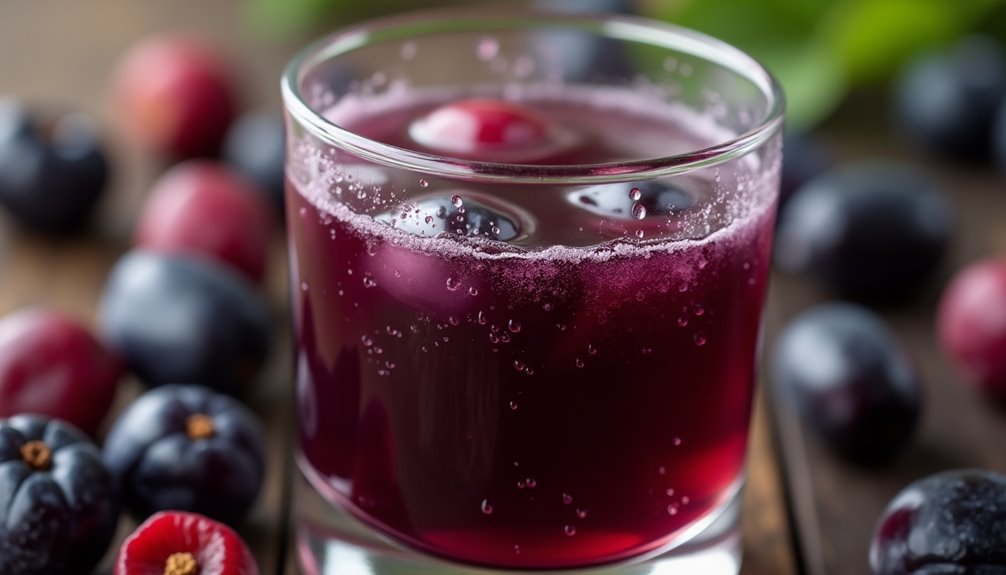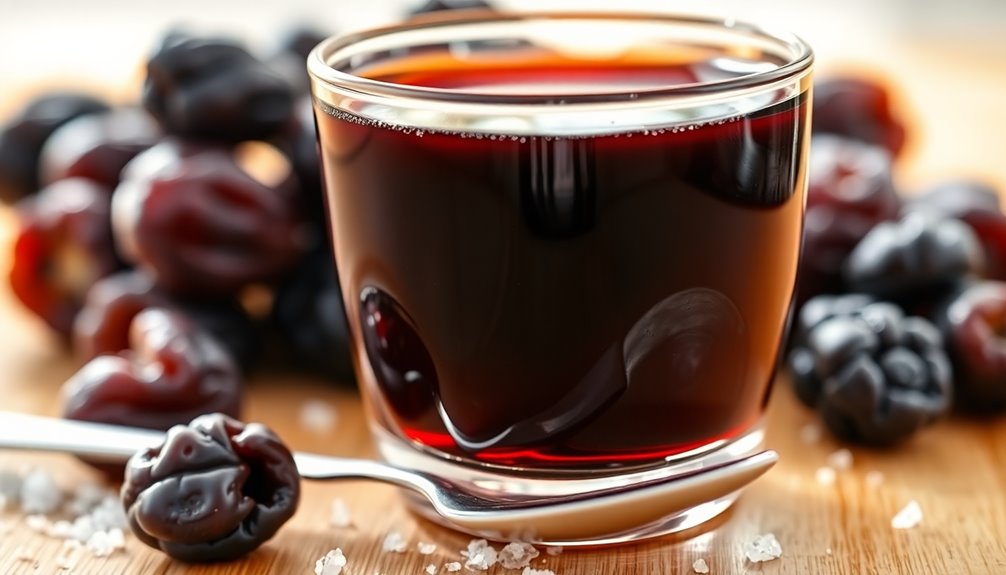An 8-ounce serving of prune juice packs about 26 grams of sugar, mainly from natural sources like fructose and glucose. If you're watching your sugar intake, this high sugar content can impact your daily allowance. It also contains fiber, which aids digestion, but moderation is key. Balancing it with lower-sugar options or mixing it with water can help. Want to better understand how prune juice fits into your diet? There's more to discover about its benefits and considerations.
Key Takeaways
- An 8-ounce serving of prune juice contains approximately 26 grams of sugar.
- A 256-gram cup of prune juice can have around 42 grams of sugar.
- The sugars in prune juice are naturally occurring, primarily fructose and glucose.
- High sugar content can impact calorie intake and blood sugar levels.
- Moderation is key, especially for those managing sugar consumption for health purposes.

When you pour yourself a glass of prune juice, you might be surprised to learn that an 8-ounce serving contains about 26 grams of sugar. This high sugar content can raise eyebrows, especially if you’re keeping a close watch on your diet. The sugars in prune juice are naturally occurring, predominantly in the form of fructose and glucose, which are simple sugars that the body absorbs quickly. While prune juice may have a high sugar content, it’s important to consider the nutritional benefits it offers, such as fiber and essential vitamins. If you’re comparing it to other juices, you might wonder how much sugar is in grapefruit juice, which generally contains around 20 grams of sugar per 8 ounces. Ultimately, moderation is key, so being aware of the sugar levels in the juices you consume can help you make informed dietary choices.
So, while you're indulging in this sweet beverage, it's essential to consider how those grams of sugar can impact your overall calorie intake.
If you're curious about the specifics, a larger 256-gram cup of prune juice can pack in about 42 grams of sugar. That's quite a hefty amount, and if you're one of the many consumers trying to manage your sugar consumption for health reasons, this information is crucial.
While the sugars in prune juice are natural, they can still contribute significantly to your daily calorie count. Depending on your dietary goals, sipping on prune juice could take up a substantial portion of your sugar allowance for the day.
Despite its high sugar content, prune juice has its perks, particularly when it comes to digestive health. It's rich in fiber, which can aid in digestion and help you maintain regularity.
The combination of sugars and fiber can create a unique balance, allowing your body to utilize the nutrients effectively while still keeping your digestive system running smoothly. So, while you're sipping that sweet glass, you're not just getting a sugar rush; you're also nourishing your body with essential nutrients.
However, if you're someone managing blood sugar levels, you'll want to approach prune juice with caution. The high sugar content can lead to spikes in blood sugar, especially if consumed in large quantities.
It's always a good idea to check in with a healthcare provider or a nutritionist to see how prune juice fits into your dietary needs. They can help you determine the right amount that won't interfere with your health goals.
In moderation, prune juice can be a delightful addition to your diet. You can enjoy it for its taste and digestive benefits, but remember to be mindful of how much you drink.
Balancing your intake with other low-sugar beverages can help keep your overall sugar levels in check. If you're looking for a sweet treat, consider mixing prune juice with water or other juices to reduce the sugar content while still enjoying its flavor.
Frequently Asked Questions
Can a Diabetic Person Drink Prune Juice?
If you're diabetic, drinking prune juice requires caution. Its high sugar content can lead to significant spikes in blood sugar levels, so moderation is key.
You might want to consult your healthcare provider before adding it to your diet. Additionally, consider alternatives like whole prunes or other low-sugar options that still offer digestive benefits without the risk.
Always monitor your carbohydrate intake to maintain better control over your blood sugar.
Is the Sugar in Prune Juice Bad?
Sugar in prune juice can seem scary, but it's not all bad! The natural sugars, mainly fructose and glucose, come from wholesome sources.
While it does have a higher sugar content, the fiber and sorbitol help regulate absorption, benefiting your digestive health.
Just remember, moderation is key. Limiting your intake to about one cup daily can help you enjoy the benefits without risking weight gain or blood sugar spikes.
Is It More Effective to Eat Prunes or Drink Prune Juice?
If you're looking for digestive health, eating whole prunes is more effective than drinking prune juice.
Prunes contain significantly more fiber and sorbitol, which can enhance their laxative effects. You'll likely experience higher stool frequency and weight with whole prunes.
Plus, they help you feel fuller, supporting weight management.
While prune juice can still provide relief, whole prunes offer additional benefits that make them the better choice for constipation relief and overall health.
How Much Sugar Is in Unsweetened Prune Juice?
When you're considering unsweetened prune juice, you'll find it typically contains about 26 grams of naturally occurring sugar per 8-ounce serving. This sugar mainly comes from fructose in the prunes.
If you're pouring a 256-gram cup, it could have up to 42 grams, depending on how it's processed.
Conclusion
In the world of beverages, prune juice is like a hidden gem—sweet on the surface but packed with benefits. Just like you might savor a rich chocolate dessert, enjoying prune juice's natural sugars (about 15 grams per cup) can be a delightful experience. It reminds you that sometimes, the sweetest things come with powerful health perks. So, next time you pour a glass, remember it's not just about the sugar; it's about embracing wellness in every drop.
Cindy thoroughly researches juicing trends, techniques, and recipes to provide readers with practical advice and inspiration. Her writing style is accessible, engaging, and designed to make complex concepts easy to understand. Cindy’s dedication to promoting the advantages of juicing shines through her work, empowering readers to make positive changes in their lives through the simple act of juicing.

















